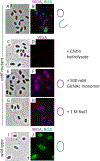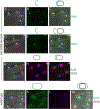Role of novel polysaccharide layers in assembly of the exosporium, the outermost protein layer of the Bacillus anthracis spore
- PMID: 35900297
- PMCID: PMC9549345
- DOI: 10.1111/mmi.14966
Role of novel polysaccharide layers in assembly of the exosporium, the outermost protein layer of the Bacillus anthracis spore
Abstract
A fundamental question in cell biology is how cells assemble their outer layers. The bacterial endospore is a well-established model for cell layer assembly. However, the assembly of the exosporium, a complex protein shell comprising the outermost layer in the pathogen Bacillus anthracis, remains poorly understood. Exosporium assembly begins with the deposition of proteins at one side of the spore surface, followed by the progressive encirclement of the spore. We seek to resolve a major open question: the mechanism directing exosporium assembly to the spore, and then into a closed shell. We hypothesized that material directly underneath the exosporium (the interspace) directs exosporium assembly to the spore and drives encirclement. In support of this, we show that the interspace possesses at least two distinct layers of polysaccharide. Secondly, we show that putative polysaccharide biosynthetic genes are required for exosporium encirclement, suggesting a direct role for the interspace. These results not only significantly clarify the mechanism of assembly of the exosporium, an especially widespread bacterial outer layer, but also suggest a novel mechanism in which polysaccharide layers drive the assembly of a protein shell.
Keywords: Bacillus anthracis; exosporium; interspace; polysaccharide; spore.
© 2022 John Wiley & Sons Ltd.
Figures













References
-
- Albers SV, and Meyer BH (2011) The archaeal cell envelope. Nat Rev Microbiol 9: 414–426. - PubMed
-
- Arroyo J, Farkas V, Sanz AB, and Cabib E (2016) ‘Strengthening the fungal cell wall through chitin-glucan cross-links: effects on morphogenesis and cell integrity’. Cell Microbiol 18: 1239–1250. - PubMed
-
- Bartels J, Blüher A, López Castellanos S, Richter M, Günther G, and Mascher T (2019) The Bacillus subtilis endospore crust: protein interaction network, architecture and glycosylation state of a potential glycoprotein layer. Molecular Microbiology 112(5): 1576–1592. - PubMed
Publication types
MeSH terms
Substances
Grants and funding
LinkOut - more resources
Full Text Sources

